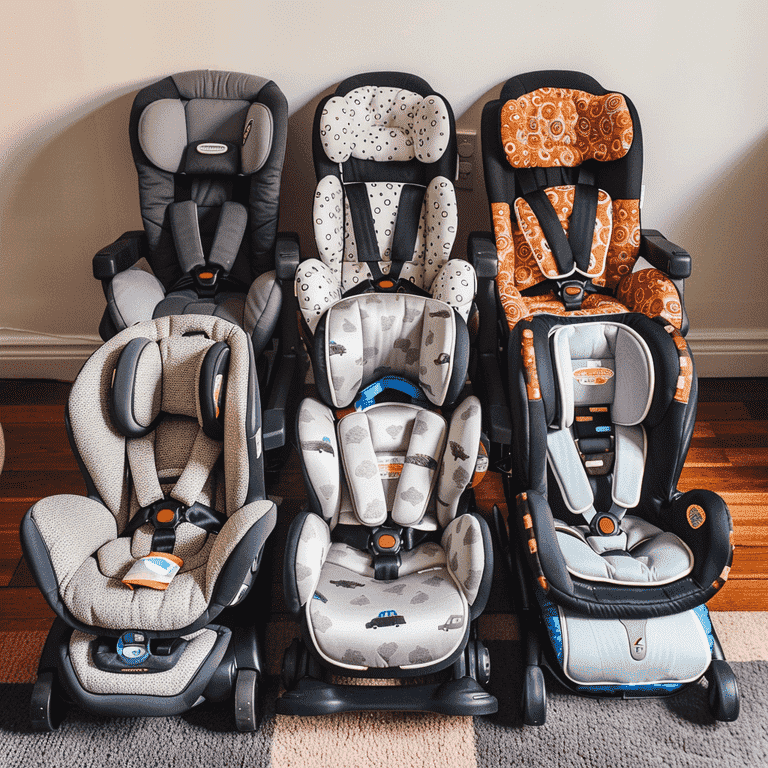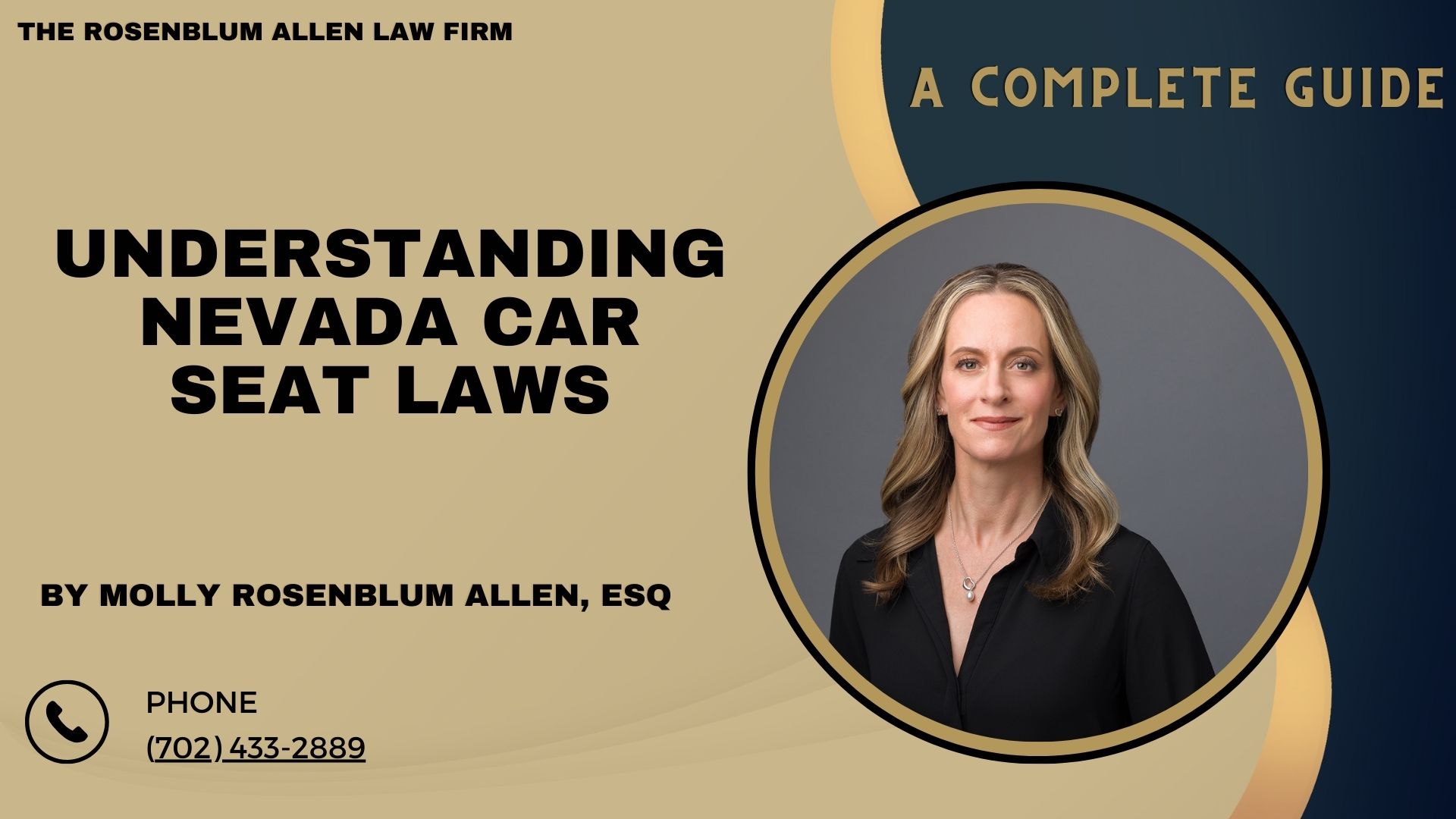Nevada focuses on child safety on the roads. The state’s car seat laws aim to keep children safe. Following these laws helps avoid fines and protects children.
Legal Requirements for Car Seats in Nevada
Age and Weight Requirements
Nevada bases its car seat laws on a child’s age and weight, adjusting as children grow.
Infants and Toddlers
Rear-facing car seat guidelines: Children under two must have a rear-facing car seat until they exceed the maker’s size limits.
Toddlers and Preschoolers
Forward-facing car seat regulations: Children over the rear-facing limit but under the age of 5 must use a forward-facing car seat.
School-aged Children
Booster seat requirements: Children 6 to 8 need a booster seat until the seat belt fits properly without it.
Adult Seat Belt
Children can switch to the seat belt when they’re at least 57 inches tall and pass the fit test, typically between ages 8 and 12.
Penalties for Non-Compliance
Not following these laws can lead to fines and points on your license.

Types of Car Seats
Choosing the right car seat involves understanding the different types available.
Rear-Facing Car Seats
These are for the youngest children, offering the best protection in a crash.
Installation best practices: Make sure the seat is at the right angle, using built-in indicators if available.
Recommended models: Pick one that fits your car and is easy to use.
Forward-Facing Car Seats
These seats are for children who have outgrown the rear-facing seat.
Installation tips: The seat should be tightly secured, with the harness snug on your child.
Top models: Choose a highly rated model that fits your child and car.
Booster Seats
Boosters raise children so the car’s seat belt fits them correctly.
Ready for a booster?: Move to a booster when your child outgrows the forward-facing seat.
Recommended boosters: Find one that correctly positions the seat belt on your child.
Convertible and All-in-One Car Seats
These seats adjust from rear-facing to forward-facing and, for all-in-ones, to a booster.
Differences: Convertibles switch between rear and forward-facing. All-in-ones go from rear-facing to booster.
Pros and cons: Convertibles are cost-effective for young children. All-in-ones offer convenience but can be more extensive and pricier.

Installation and Safety Tips
You must install your car seat correctly. And, you must securely fasten your child. This is crucial for their safety. Let’s go through some key points.
Proper Installation Techniques
A well-installed car seat is a cornerstone of child safety in vehicles. Follow these steps:
Read the manual: Your car seat and vehicle manuals are your best guides.
Choose LATCH or seat belt: Use one method to secure the car seat tightly.
Check stability: A properly installed car seat shouldn’t move over an inch.
Securing Your Child in the Car Seat
Ensuring your child is snug and secure in their car seat is as important as the installation.
Harness snugness: You shouldn’t be able to pinch the harness strap near the shoulder.
Chest clip position: It should be level with your child’s armpits.
Car Seat Inspection and Assistance
If you need help with your car seat installation, help is available.
Inspection stations: Many local fire stations, hospitals, and police stations offer free car seat checks.
Certified technicians: They can ensure your car seat is installed correctly and show you how to do it yourself.
Public Transportation
Using a car seat on public transit can be hard. But, it’s vital for your child’s safety. Here’s what to keep in mind:
Buses: Not all buses have seat belts, but if available, secure your car seat as you would in a car. Always aim for a seat with a belt.
Taxis and Rideshares: Always bring your car seat. While some taxis and rideshares might offer car seats, you can’t be sure of their safety or suitability for your child.
Traveling by Air
Air travel requires special considerations for car seats:
FAA Approval: Ensure your car seat is FAA-approved for use on airplanes. This information is typically found on the car seat’s label.
Booking Seats: When possible, book a seat for your child and use the car seat on the plane. It’s the safest way for young children to fly.

Updates and Recalls
To stay on top of car seat safety, you need to know about any updates or recalls. These could affect your car seat.
Keeping Your Car Seat Up to Date
Manufacturers occasionally update car seat models, or issue recalls for safety reasons.
Registration: Always register your car seat with the manufacturer to be notified of any recalls.
Regular Checks: Periodically check the National Highway Traffic Safety Administration (NHTSA) website for any recalls or safety notices regarding your car seat model.
When to Replace a Car Seat
Car seats don’t last forever. Knowing when to replace them is critical to maintaining safety.
After an Accident: Replace your car seat after a moderate to severe crash to ensure safety. Consult your manual or the manufacturer for guidance after minor accidents.
Expiration: Car seats have expiration dates, typically 6 to 10 years from the date of manufacture. Materials can degrade over time, so adhering to these limits is essential.
Ensuring your child’s safety while traveling involves more than buying a car seat. It requires regular maintenance, awareness of safety updates, and adapting to different

Breaking It All Down
Picking the right car seat and using it correctly is crucial for your child’s safety on the road. We’ve covered the car seat laws in Nevada. Also, the different kinds of car seats, how to install them right, and how to keep them safe in all kinds of vehicles. We also discussed the need to keep up with the latest car seat updates. It’s important to know when it’s time for a new one.
Keeping your child safe is more than just following the rules. It’s about making smart choices and being proactive. A car seat is your child’s best protection in a car accident. You do your best to keep your child safe. You do this by choosing the right car seat, installing it correctly, and always using it.
We encourage you to use the available resources. These include online guides, local car seat inspections, and advice from safety professionals. Your efforts in car seat safety make a big difference in keeping your child safe on every trip.
Stay safe, stay informed, and always ask for help of car seat safety if you need it. Taking care of your child’s safety is an ongoing effort, and we’re here to help you through it.

Frequently Asked Questions
Can I use a car seat from another country in Nevada?
Car seats from other countries might need to meet US safety standards. It’s best to use a car seat that meets US regulations. The National Highway Traffic Safety Administration (NHTSA) should certify it.
How do I know if my car seat is installed tightly enough?
A properly installed car seat should not move more than an inch in any direction. Press firmly on the seat as you tighten the straps or the LATCH system to cut movement.
Can I use a second-hand car seat?
Using a second-hand car seat is only recommended if you know its entire history. Never use a car seat that’s been in an accident, is missing parts, or is past its end date.
Do car seats expire?
Yes, car seats expire. The end date is usually found on the seat’s label or imprinted on the plastic. End dates range from 6 to 10 years from manufacture due to the degradation of materials over time.
Is it safe to put a car seat in the front seat?
Children should always ride in the back seat, ideally until they are at least 13 years old. The back seat is safer, especially if the front passenger has an airbag.
What do I do with my car seat once it’s expired or no longer needed?
Many communities have recycling programs for expired or unwanted car seats. Check with your local waste management facility for options. Otherwise, it’s best to cut the straps, label them as expired or unsafe, and dispose of them to prevent future use.
How can I ensure my child is warm enough in their car seat during winter?
Dress your child in thin layers. Use a coat or blanket over the harness straps, not under them. This keeps the harness snug against your child’s body. Bulky clothing can prevent a snug harness fit.
What should I do if my child unbuckles themselves while I’m driving?
If your child unbuckles, find a safe place to pull over and re-buckle them. It’s important to consistently reinforce the importance of staying buckled up for safety.
Are booster seats required in Nevada?
Yes, children from about age six until they are big enough to use the adult seat belt need a booster seat. The exact requirements can depend on the child’s size and age.
How often should I check the installation of my car seat?
It’s a good idea to check your car seat’s installation often. Follow these steps, especially after a long trip or if you have moved the seat. Also do it if your child has grown a lot. Checking monthly is a good practice.
Can I install a car seat in the middle of the back seat?
If your vehicle allows it, the car seat can be securely installed in that position. The middle of the back seat is often considered the safest spot in the vehicle for a car seat.

Glossary
Car Seat: A safety device that protects children from injury or death during vehicle collisions.
NHTSA (National Highway Traffic Safety Administration): A federal agency dedicated to achieving the highest safety standards on the nation’s roads.
LATCH (Lower Anchors and Tethers for Children): A system for installing car seats using built-in anchors and tethers in the vehicle instead of the seat belt.
Rear-Facing Car Seat: A car seat positioned to face the back of the vehicle, providing increased protection for infants’ and toddlers’ heads, necks, and spines.
Forward-Facing Car Seat: A car seat positioned to face the front of the vehicle, designed for children who have outgrown the rear-facing position.
Booster Seat: A seat that raises a child to the proper height for the car’s seat belt to fit correctly, typically used after a child outgrows a forward-facing seat.
FAA Approval: Certification that a car seat meets the Federal Aviation Administration’s standards for use on airplanes.
Expiration Date: The date after which a car seat should no longer be used due to potential degradation of materials that can compromise safety.
Seat Belt Fit Test: A method to determine if a child is ready to transition from a booster seat to using the car’s seat belt alone, based on how the seat belt fits across the child’s body.
Installation Station: A location where certified technicians provide free car seat installation help and safety checks to the public.
Convertible Car Seat: A car seat that can convert from rear-facing to forward-facing, accommodating a child as they grow.
All-in-One Car Seat: A car seat that can change from rear-facing to forward-facing and then to a booster seat, designed to be the only car seat a child will need.
Harness: The straps on a car seat hold a child securely.
Chest Clip: A clip on a car seat harness that holds the harness straps over the child’s chest at armpit level.
Recall: A safety alert issued by a manufacturer or the NHTSA when a car seat or any of its components is found to be unsafe or defective.

Additional Resources for You
Our lead attorney, Molly Rosenblum Allen, Esq., has created several resources for those in need of legal assistance. Here’s a straightforward guide to what we offer:
Las Vegas Personal Injury Attorney: If you’ve been injured due to someone else’s negligence, learn how we can help you secure the compensation you deserve. Explore more.
Las Vegas Car Accident Attorney: Car accidents can have devastating consequences. Find out how we assist victims in navigating the legal process. Learn more.
Motorcycle Accident Lawyer Las Vegas: Motorcyclists face unique dangers on the road. Discover how we advocate for riders’ rights and recovery. Read more.
Wrongful Death Lawyer Las Vegas: Losing a loved one is incredibly painful, especially if it was due to negligence. See how we can help you seek justice. Find out more.
Truck Accident Attorney Las Vegas: Truck accidents often result in serious injuries. Get information on how we support victims through legal challenges. Check here.
Las Vegas Drunk Driving Accident Attorney: Drunk driving accidents are preventable tragedies. Learn about the support and representation we offer. Visit this link.
Las Vegas Slip and Fall Attorney: Slip and fall accidents can occur anywhere, often due to negligence. Understand how we assist in these cases. Click here.

Outside Resources for You
National Highway Traffic Safety Administration (NHTSA): A key resource for information on vehicle safety, including car seats and road safety guidelines. Visit NHTSA.
American Association for Justice: An organization that promotes fairness and justice through the legal system, focusing on protecting the rights of those injured by negligence or misconduct. Explore AAJ.
American Bar Association: Offers resources for the public, including legal guides and information on finding legal assistance. Check out ABA.
Safe Kids Worldwide: Dedicated to preventing injuries in children, this organization provides resources on child safety, including car seat safety tips. Discover Safe Kids Worldwide.
Insurance Institute for Highway Safety (IIHS): Provides ratings for vehicle safety and evaluations of car seats for crash protection and ease of use. Learn more at IIHS.
Consumer Reports: Offers buying guides, product reviews, and ratings, including evaluations of car seats and tips for child safety. Visit Consumer Reports.
National Safety Council: A nonprofit organization focused on promoting health and safety at home, in vehicles, and in the workplace. Explore NSC.

A Special Message from Our Lead Attorney, Molly Rosenblum Allen, Esq

Dear Readers,
Thank you for taking the time to explore the resources we’ve provided. We understand that dealing with legal challenges can be overwhelming, and it’s our mission to offer guidance and support through every step of your journey. Your well-being and peace of mind are our top priorities.
If you need further assistance or have questions about your situation, please don’t hesitate to contact me and my team at The Rosenblum Allen Law Firm. You can contact us at (702) 433-2889 to discuss how we can assist you in moving forward with your case.
Warmest regards,
Molly Rosenblum Allen, Esq.



